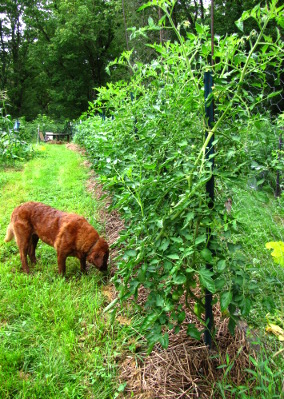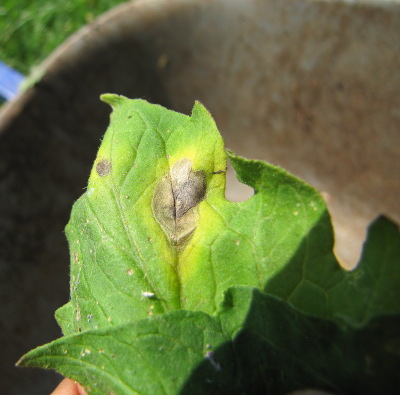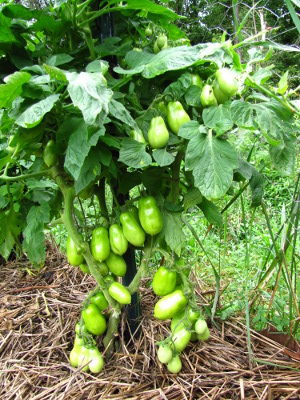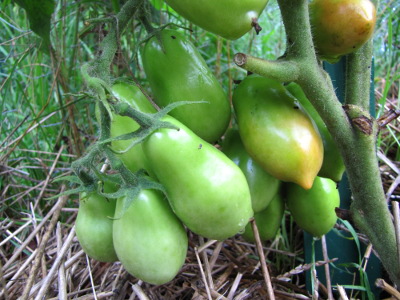
Preventing tomato blights in wet climates
 Tomatoes
can be some of the easiest vegetables to grow, but only if you have a
long, hot (but not too hot), dry (but not too dry) growing
season. We struggle with tomatoes in non-drought years because
our seemingly endless rains breed fungi that take out our crops.
I've posted about preventing tomato blights in bits and pieces before,
but I thought I'd pull all of our anti-blight measures together into
one post to make it easier for you to follow along.
Tomatoes
can be some of the easiest vegetables to grow, but only if you have a
long, hot (but not too hot), dry (but not too dry) growing
season. We struggle with tomatoes in non-drought years because
our seemingly endless rains breed fungi that take out our crops.
I've posted about preventing tomato blights in bits and pieces before,
but I thought I'd pull all of our anti-blight measures together into
one post to make it easier for you to follow along.
Plant
your tomatoes in the sunniest spot. This year, we made an
extra bed running the length of the chicken pasture just for our
tomatoes. The fence line runs from east to west on the most
northern side of the yard, so this location gets the least shade from
the hillside and the plants are least likely to shade each other.
The only slight problem with this setup is that grasses on the pasture
side of the fence poke through the chicken wire, but they don't seem to
bother the tomatoes and I yank them out when I weed.
Space
the tomatoes far apart. The distance you
choose to provide between your tomato plants will depend on your
pruning method, but the goal is to make sure there's open air between
them. We prune to three main stalks and tie the plants to a
stake, so we only need about three feet between plants. If you've
got space, more room is always better.
Stake
your tomatoes.
You may be starting to notice that all of these techniques have a
common theme --- keeping the leaves of the tomatoes dry. It's a
big no-no to let your tomatoes sprawl across the ground since they'll
take much longer to dry off after a rain or even a heavy dew.
Cages are okay, but hinder air circulation. We tie up our
tomatoes once a week to keep them climbing their stake.
 Prune relentlessly. Blight spores splash
up from the ground onto tomato leaves, where the fungi grow and
reproduce, producing more spores than can spread through your whole
patch. As soon as the tomatoes are about eight inches tall, I cut
off any leaves touching the ground, a process that I repeat weekly
since the higher leaves will start to bend down as they grow
older. Meanwhile, I snip off any signs of incipient fungal damage
--- early
blight showed up at
the beginning of July, but with constant leaf removal, seems to be in
check. Finally, I remove all suckers, leaving only three main
stems. When pruning, clean your clippers with an alcohol-soaked
rag between each plant and after you cut any dicey-looking
foliage. It's okay to let healthy leaves and stems fall to the
ground, but take diseased leaves as far away as possible or burn
them. If a plant seems to be nearly all diseased, rip the whole
thing out ASAP rather than hoping you can baby it back to life.
Prune relentlessly. Blight spores splash
up from the ground onto tomato leaves, where the fungi grow and
reproduce, producing more spores than can spread through your whole
patch. As soon as the tomatoes are about eight inches tall, I cut
off any leaves touching the ground, a process that I repeat weekly
since the higher leaves will start to bend down as they grow
older. Meanwhile, I snip off any signs of incipient fungal damage
--- early
blight showed up at
the beginning of July, but with constant leaf removal, seems to be in
check. Finally, I remove all suckers, leaving only three main
stems. When pruning, clean your clippers with an alcohol-soaked
rag between each plant and after you cut any dicey-looking
foliage. It's okay to let healthy leaves and stems fall to the
ground, but take diseased leaves as far away as possible or burn
them. If a plant seems to be nearly all diseased, rip the whole
thing out ASAP rather than hoping you can baby it back to life.
Choose
resistant varieties. We've tried out dozens
of tomato varieties, but now focus on ones that are a bit more
resistant than normal to early blight, late blight, and septoria leaf
spot (our three main problems.) None of these tomatoes are
entirely immune, though, so we can't ignore them and hope for the best.
Water
from below and/or in the early morning. If you have to get the
leaves of your tomatoes wet, make sure you do it first thing in the
morning on a sunny day so that the plants will dry off as soon as
possible. I've located our sprinklers so that they don't hit the
main tomato area, but we haven't got our drip irrigation installed
yet. The plants seem to be doing fine without the extra water so
far.
 Race the blight. Of our three main fungal
diseases, late
blight is the real doozy, and it tends to hit late in the season just
as the name suggests. For fresh eating, it would be great to have
ripe tomatoes all summer, but if you put away a lot of sauces, it
wouldn't hurt to try out some determinate tomatoes. This year,
over half of our total tomato planting is devoted to Martino's Roma,
which will drown you in tomatoes for a month or two and then peter
out. Another facet of racing the blight is to make sure your
plants are always growing as fast as possible by providing lots of
manure and not starting the seedlings too early (allowing them to be
stunted.)
Race the blight. Of our three main fungal
diseases, late
blight is the real doozy, and it tends to hit late in the season just
as the name suggests. For fresh eating, it would be great to have
ripe tomatoes all summer, but if you put away a lot of sauces, it
wouldn't hurt to try out some determinate tomatoes. This year,
over half of our total tomato planting is devoted to Martino's Roma,
which will drown you in tomatoes for a month or two and then peter
out. Another facet of racing the blight is to make sure your
plants are always growing as fast as possible by providing lots of
manure and not starting the seedlings too early (allowing them to be
stunted.)
And now, two blight
prevention tactics that we've tried which have failed miserably:
- Stick your head in the sand and pretend nothing's happening.
- Plant patches of tomatoes here and there and hope the blight won't reach them all.
 Despite
lots of rain, we seem to be in great tomato shape this year. We
ate 2011's first tomato (a Stupice) on July 12 and have enjoyed a
tomato every other day since. The main crop is about to come in,
at which point I'll be preserving as fast as possible and quickly
forgetting that a sun-ripened tomato is a rare treat.
Despite
lots of rain, we seem to be in great tomato shape this year. We
ate 2011's first tomato (a Stupice) on July 12 and have enjoyed a
tomato every other day since. The main crop is about to come in,
at which point I'll be preserving as fast as possible and quickly
forgetting that a sun-ripened tomato is a rare treat.
Want more in-depth information? Browse through our books.
Or explore more posts by date or by subject.
About us: Anna Hess and Mark Hamilton spent over a decade living self-sufficiently in the mountains of Virginia before moving north to start over from scratch in the foothills of Ohio. They've experimented with permaculture, no-till gardening, trailersteading, home-based microbusinesses and much more, writing about their adventures in both blogs and books.
Want to be notified when new comments are posted on this page? Click on the RSS button after you add a comment to subscribe to the comment feed, or simply check the box beside "email replies to me" while writing your comment.

We haven't made a great effort to hunt down specifically resistant varieties because it seems like the ones that are resistant to one fungus are quite susceptible to another. However, any varieties that repeatedly succumb to something get deleted from our planting list.
Here are the tomatoes we're growing this year with a note on any special resistance I've noticed:
Yellow Roma - an indeterminate to extend our roma season. Seems a bit more resistant to early blight than Martino's Roma is, but doesn't set as many fruits as early, so overall yields tend to be lower (especially if late blight hits.)
Martino's Roma - more resistant to late blight than the bigger romas we'd tried (Russian Roma, San Marzano)
Blondkopfchen - no real resistance, but we like the sweet, tiny, very copious yellow fruits
Ken's red - a good slicer.
Crazy - resistant to late blight. Also, our second earliest tomato to fruit most years
Early pick - Despite the name, doesn't seem as early as Crazy and Stupice. Can't remember its resistance, but it wasn't awful. Good slicer.
Stupice - Our earliest tomato, and pretty resistant to early blight and septoria leaf spot.
try to add my experience in gardening, healthy plants result does not span to pests, diseases, and not easily stressed by conditions of uncertainty, so take care of the plants, good adequacy of nutrients and control pests + diseases of plants, and do not let the plants attacked severe mealybug pest because it can easily lead to disease.
from my experience, the implementation of biological agents that are combined with the use of organic fertilizer could make the plant more healthy, especially I was able to remove the dependency of chemical fertilizers and chemical pesticides. but this implementation requires patience and diligence of the farmers themselves.